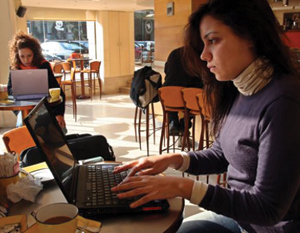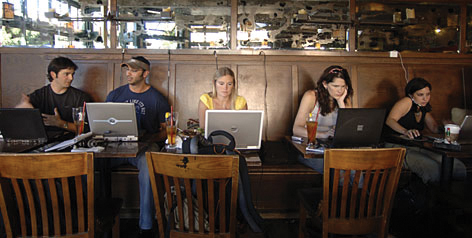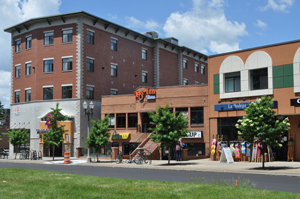Building the Case
The research is compelling. Attracting and retaining talent is critical if Michigan is to prosper in a knowledge-based economy. Transitioning from an industrial-based economy to a knowledge-based economy requires a more educated work force. If Michigan is going to be economically competitive, then it needs to become smarter. Currently, only 25.2 percent of the Michigan population holds a bachelor’s degree or higher. This compares to 28.1 percent for the country. Looking at
other states in a similar geographic area, Minnesota is at 31.8 percent and Illinois is at 30.7 percent. These are states with thriving large urban centers. States and major cities with the largest populations of college educated, talented, and creative people are winning economically with lower unemployment rates and higher per-capita income levels. The most successful economies are those that are concentrated in the knowledge-based sectors. In the United States, job growth from 1990-2012 was 34 percent in high education industries versus 14 percent in low education industries.
Michigan, with its world-class higher learning institutions, attracts students not only from in-state, but from all over the world. Our challenge is to encourage these students to stay after college. The likelihood of moving after their 25th birthday declines by half. We need to get them engaged in their communities so that they will choose to settle down here, raise families, start and grow jobs, and invest in Michigan for the long term.
In a global economy where technology allows people to work anywhere, research shows that of those students who leave Michigan, two-thirds of them are choosing where to live first then looking for a job—and they are overwhelmingly choosing to live in cities. This is a transformative approach from a generation ago when people followed the jobs. We know that talent is attracted to vibrant places with robust services and amenities. This includes a strong emphasis on arts and cultural pro-grams, physical design and walkability, transit options, connectivity, and an entrepreneurial environment, as well as public safety.
Nontraditional households are on the rise, with less than 25 percent of households consisting of a mother, father and children living under the same roof. Today, auto-motive miles driven by 21-30 year-olds is 13.7 percent versus 20.8 percent in 1995 and 18.3 percent in 2001.8 These are demographic shifts which are driving dramatic changes in how we design our communities. We must offer communities with the diversity of choices in housing, transportation, activities, and recreation that is required by talent, or we will remain at a competitive disadvantage.
Proposed Policy Actions
In order to fully position our communities to attract and retain talent, we must advance policies that provide appropriate tools for modern development as well as fund and support cultural and place-based priorities—allowing communities to further reach sustainability. To that end, the following recommendations are proposed:
-
Advocate for a wide range of housing choices (affordable, rental and owner-occupied housing). As mentioned, with shifting demographics showing that less than 25 percent of households are considered traditional (mother, father, and children), young people are choosing to rent over purchasing a home and with a want/need of much less square footage than a generation ago. Since our focus over the past decades has been to build large homes away from central cities and located in single-use areas, there is a huge housing shortage for what young people desire. In a recent blog, titled “Growing Detroit II”, Michigan Future, Inc. strongly proposes that development incentives through historic preservation and brownfield tax credits need to be restored. For decades and continuing today, the
government has subsidized suburban housing (single family, home ownership). It’s time that subsidizing urban housing (multifamily, mixed-use, and largely rental) be supported.
-
Promote mixed-use development, which includes businesses, retail, restaurants, and housing and build a live-and-work environment to create a more sustainable way of living. Single-use zoning construction makes no economic sense. Charles Marohn, executive director of Strong Towns in Brainerd, Minnesota, illustrates the economic impact of a Walmart business and a mixed-use building in Asheville, North Carolina. In this particular case, Walmart takes up 34 acres of land and brings in $6,500 of total property taxes per acre. In contrast, the mixed-used development which occupies 00.2 acre, brings in $634,000 of total property taxes per acre. Retail taxes per acre to the city are $47,000 for Walmart versus $83,600 for the mixed-use building. Jobs per acre are 5.9 for Walmart and 73.7 for the mixed-use development. With numbers like these, we need to focus our resources on multi-use investments that will strengthen the economic base and provide the type of communities people want to live in. Michigan State Housing Development Authority (MSHDA) and Michigan Economic Development Corporation (MEDC) are state agencies that could provide additional incentives for multi-use development.
-
Forgive student loans on an incremental basis depending on the length of time spent in Michigan. Give a refundable loan of up to $8,000 to each public university and community college student. Each year a student remains in Michigan after graduation, 20 percent of the loan will be forgiven. Another option is to forgive the loan by 10 percent for 10 years. Other cities and states are developing these programs. Kansas has already seen in increase in college graduates applying for their program, and 1/3 of them are from out of state. And, Niagra Falls, NY is implementing their own program now. The race for talent is on—and we must choose to get in and compete.
-
It is important that funding be available to create robust internship programs that link new graduates with small and large businesses, nonprofits and foundations to gain real-world situations. Some of that burden could be shifted to businesses to help combat the state’s brain drain by offering tax credits for those businesses that develop ongoing intern programs. One program that already exists in Michigan is the Intern in Michigan program. It connects students and employers through a
unique online matching system. This is a creative approach to retaining and connecting talent which could be incentivized and promoted, as with other similar programs.
-
Underinvesting in the cultural arts makes no economic sense. The arts, culture, arts education, and creative industries are huge economic drivers that provide a rich quality of life and help attract and retain people of all ages. Jobs, tax revenue,
and vibrant communities are all dependent upon the creative state of our economy. Using data provided by the Cultural Data Project, Creative State Michigan illustrates that for every $1 Michigan invests in arts and culture, $51 is pumped back into the state’s economy.13 It is critical that the State supports the arts at a much higher level than it has been doing during the past decade.
Download: Partnership for Place: An Agenda for a Competitive 21st Century Michigan


 government has subsidized suburban housing (single family, home ownership). It’s time that subsidizing urban housing (multifamily, mixed-use, and largely rental) be supported.
government has subsidized suburban housing (single family, home ownership). It’s time that subsidizing urban housing (multifamily, mixed-use, and largely rental) be supported.  unique online matching system. This is a creative approach to retaining and connecting talent which could be incentivized and promoted, as with other similar programs.
unique online matching system. This is a creative approach to retaining and connecting talent which could be incentivized and promoted, as with other similar programs.